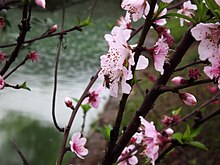Peach
The peach (Prunus persica) is a deciduous tree native to the region of Northwest China between the Tarim Basin and the north slopes of the Kunlun Mountains, where it was first domesticated and cultivated.[3] It bears edible juicy fruits with various characteristics, most called peaches and others (the glossy-skinned, non-fuzzy varieties), nectarines.
| Peach | |
|---|---|
 |
|
| Peach flower, fruit, seed and leaves as illustrated by Otto Wilhelm Thomé (1885) | |
 |
|
| Autumn Red peaches, cross section showing freestone variety | |
|
Scientific classification |
|
| Kingdom: | Plantae |
| Clade: | Tracheophytes |
| Clade: | Angiosperms |
| Clade: | Eudicots |
| Clade: | Rosids |
| Order: | Rosales |
| Family: | Rosaceae |
| Genus: | Prunus |
| Subgenus: | Prunus subg. Amygdalus |
| Species: |
P. persica
|
| Binomial name | |
|
Prunus persica |
|
| Synonyms[2] | |
|
Synonymy
|
|
The specific name persica refers to its widespread cultivation in Persia (modern-day Iran), from where it was transplanted to Europe. It belongs to the genus Prunus, which includes the cherry, apricot, almond, and plum, in the rose family. The peach is classified with the almond in the subgenus Amygdalus, distinguished from the other subgenera by the corrugated seed shell. Due to their close relatedness, the kernel of a peach stone tastes remarkably similar to almond, and peach stones are often used to make a cheap version of marzipan, known as persipan.[4]
Peaches and nectarines are the same species, though they are regarded commercially as different fruits. The skin of nectarines lacks the fuzz (fruit-skin trichomes) that peach skin has; a mutation in a single gene (MYB25) is thought to be responsible for the difference between the two.[5][6]
In 2018, China produced 62% of the world total of peaches and nectarines.[7]
Description
Prunus persica grows up to 7 m (23 ft) tall and wide, but when pruned properly, trees are usually 3–4 m (10–13 ft) tall and wide.[8] The leaves are lanceolate, 7–16 cm (3–6+1⁄2 in) long, 2–3 cm (3⁄4–1+1⁄4 in) broad, and pinnately veined. The flowers are produced in early spring before the leaves; they are solitary or paired, 2.5–3 cm diameter, pink, with five petals. The fruit has yellow or whitish flesh, a delicate aroma, and a skin that is either velvety (peaches) or smooth (nectarines) in different cultivars. The flesh is very delicate and easily bruised in some cultivars, but is fairly firm in some commercial varieties, especially when green. The single, large seed is red-brown, oval shaped, around 1.3–2 cm long, and surrounded by a wood-like husk. Peaches, along with cherries, plums, and apricots, are stone fruits (drupes). The various heirloom varieties including the 'Indian Peach', or 'Indian Blood Peach', which ripens in the latter part of the summer, and can have color ranging from red and white, to purple.[9]
Cultivated peaches are divided into clingstones and freestones, depending on whether the flesh sticks to the stone or not; both can have either white or yellow flesh. Peaches with white flesh typically are very sweet with little acidity, while yellow-fleshed peaches typically have an acidic tang coupled with sweetness, though this also varies greatly. Both colors often have some red on their skins. Low-acid, white-fleshed peaches are the most popular kinds in China, Japan, and neighbouring Asian countries, while Europeans and North Americans have historically favoured the acidic, yellow-fleshed cultivars.
Etymology
The scientific name persica, along with the word "peach" itself and its cognates in many European languages, derives from an early European belief that peaches were native to Persia (modern-day Iran). The Ancient Romans referred to the peach as malum persicum "Persian apple", later becoming French pêche, whence the English "peach".[10] The scientific name, Prunus persica, literally means "Persian plum", as it is closely related to the plum
-
Previous
- Page 1 of 2
- Next









































